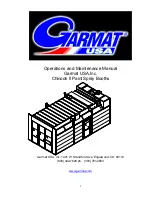
Getting started
Appliance test
socket 110 V
Flash test socket
(PAT 350 only)
Firmware
upgrade port
Power off /
Escape and
Home keys
Test keypad –
See Test key layout
Extension lead
/ IEC lead test
socket
Appliance test
socket (230 V)
Fuse checker
Display
Display
navigation
UP/DOWN/
LEFT/RIGHT
and OK
TEST button
Earth bond and
insulation
test probe socket
NOTE: Do not connect any equipment until the PAT tester
has been switched on and passed a self test.
Instrument and test key layout
test probe socket
Lead null
post
Note: The PAT320 does not include the Flash test option.
Note: The PAT320 does not include the Flash test option.
Quick Start guide
M
PAT300 Series Portable Appliance Testers
G
Safety Warnings and symbols used
The following safety warnings and precautions
must
be read and understood before
the instrument is used. They must be observed during use.
■
For safety, only connect the PAT to a supply that is properly earthed. If in doubt,
the supply should be checked by a qualifi ed electrician.
■
Do not use
the instrument if there are any signs of damage.
■
All test leads, probes and clips must be in good order, clean and with no broken or
cracked insulation.
■
Probes and clips should be held behind the fi nger guard.
■
Test leads not used during a measurement should be disconnected from the
appliance tester.
■
For dual voltage testers, both sockets can be live simultaneously.
■
Only connect one asset to the PAT during testing.
■
Tests should be carried out in the order recommended below. An appliance that
fails a test should be repaired before further testing is carried out.
Recommended Sequence:
1. Earth Bond/ Continuity of the protective earth conductor (Class I devices)
2. Insulation test (or earth leakage)
In addition further tests can be performed
3. Operation test
4. Leakage test
■
Only perform an operational test after the earth bond and insulation tests
have been completed, as this test operate at mains voltage.
■
During testing, ensure no hazard will exist as a result of normal running or
under fault conditions.
■
During testing the unit under test (asset) should not be touched, other than
using the appropriate accessories, as faulty appliances can present a shock
hazard.
■
Do not touch the exposed parts of test leads during tests as hazardous
voltages may be present due to potentially faulty appliance.
■
Do not touch the IEC extension lead socket pins especially during a test, as
hazardous voltages may be present due to a potentially faulty appliance
■
Assets should not be routinely Flash tested. Where fl ash testing is required,
refer to further guidance on Flash testing, section 4.5.
■
Replacement fuses must be of the correct rating and type. Refer to section 6.3
■
The USB connection should only be used by approved service personnel,
nothing should be connected to the USB port during testing.
■
Only use NiMH rechargeable 9V PP3 battery, do not use a non rechargeable type
Note: The PAT320 does not include the Flash test option.
Note: The PAT320 does not include the Flash test option.
as this could become dangerous if charged by the instrument.
■
Serviceable fuses should only be replaced with those that are suitably rated
■
In case of an emergency use an easily accessible power point
Safety symbols used on the instrument
F
Caution: risk of electric shock
G
Caution: refer to accompanying notes. When displayed at the start of an
insulation test, warns that a hazardous voltage may exist at the test lead
probes
c
Equipment complies with the relevant EU Directives
f
Fuse
HV test lead in unlocked position
HV test lead in locked postion
Battery type fi tted
DO NOT connect to 230 V supply
Battery function -
A 9 V PP3 rechargeable NiMH battery is fi tted to allow fast
restart should the PAT be unplugged and reconnected to an electrical supply in less
than 5 minutes.
Battery replacement
Warning:
■
Do not switch the instrument on with the battery cover removed
or test leads connected.
■
Only use NiMH rechargeable batteries.
1. Switch off the instrument and disconnect the instrument from any electrical
circuits.
2. Remove the battery cover.
3. Remove the old battery and refi t a new one, observing the terminal polarity.
4. Replace the cover and retaining screw.
Note: The PAT320 does not include the Flash test option.
All test leads, probes and clips must be in good order, clean and with no broken or
Test group 1 to 5
Description
1 Class I test
For testing assets with an earth return conductor
2 Class II test
For testing assets without an earth return conductor
3 IEC lead and For testing extension leads and IEC type power leads
Extension
(found on computers, kettles etc)
lead test
4 RCD tests
For testing Plug-in RCDs and extension leads fi tted
with RCDs
5 Information
Provides technical support details
Individual tests 6 to 10
6 Bond
Ω
Performs an earth bond/continuity test at 200 mA,
10 A or 25 A
7 INS M
Ω
Performs an insulation test at either 250 V or 500 V
8 LEAK mA
Performs an earth leakage test
9 LOAD VA
Performs a RUN test and measures the power drawn
10 1.5 kV/3 kV
Performs a fl ash test at the required voltage
Test key layout
Test groups summary
Fuse replacement
Warning: Do not switch the instrument on with the fuse cover
removed or test leads connected.
1. Switch off the instrument and disconnect (the instrument) from any
electrical circuits.
2. Remove the fuse cover.
3. Replace the blown fuse with the correct type and rating.
4. Replace the fuse cover.
1
2
3
4
5
6
7
8
9
10




















